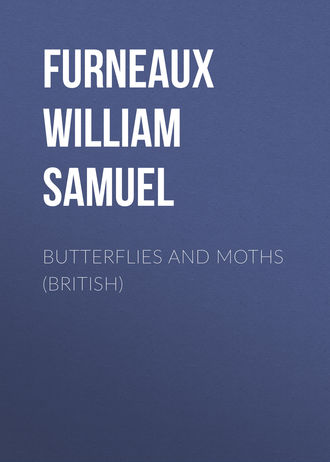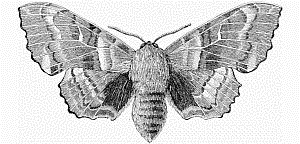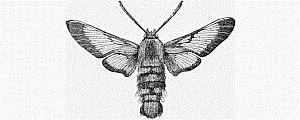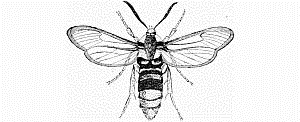 полная версия
полная версияButterflies and Moths (British)
The fore wings of this moth are of a very rich dark brown, beautifully mottled with lighter tawny shades, and with a small but conspicuous yellow dot near the centre. The hind wings are yellow, with a black band and margin; and the body is yellow, with six broad black bands, and six large blue spots down the middle.

Fig. 97. – The Death's-Head Hawk Moth.
The moth is rather widely distributed, and even common in some parts, but is not nearly so often met with as the larva. It is on the wing during August and September.
It is probable that the reader will never have an opportunity of capturing the perfect form of this remarkable species, but he may with a little perseverance obtain some caterpillars and rear them. These larvæ feed on the potato, the deadly nightshade (Atropa Belladonna), and the woody nightshade (Solanum Dulcamara); and they are well known to potato growers in some parts of the country.
The colour of the caterpillar is generally pale yellow, with numerous small black dots, and seven oblique violet stripes on each side. The horn is yellowish and rough, and is bent downward, but recurved again at the tip.
It feeds during the night, and remains hidden throughout the daytime. In August it is fully grown, and then retires into the ground to undergo its transformations.

Fig. 98. – The Larva of Atropos.
The Privet Hawk (Sphinx Ligustri)
This is another fine moth, measuring nearly four and a half inches from tip to tip. It is represented in the centre of Plate IX in its natural colours, so that it need not be described.
The perfect insect flies in June and July, and, although common, is not frequently seen at large. The larvæ, however, are to be met with in abundance in privet hedges. Even in the centres of large towns we may see them resting on the topmost twigs of a privet hedge, their beautiful green tint closely resembling that of the surrounding leaves. After a little experience they may be readily discerned by a careful observer, but there are certain signs by which their presence may be proved before they have been actually seen. Sometimes a number of the twigs are completely stripped of their leaves, even the midribs and the leaf stalks being almost or entirely devoured; and beneath the bushes are the large black masses of excrement that tell of the marauders above. When found, these larvæ should always be removed on a piece of the twig to which they are attached, for they hold on so firmly by their claspers that it is sometimes almost impossible to remove them from their hold without injury.
These caterpillars may easily be distinguished from those of the other 'hawks' by the seven oblique stripes which adorn the sides. These are each composed of two colours, white and lilac, and form a pretty contrast with the bright green of the rest of the body. The horn is smooth and curved, and is black with the exception of part of the under side, which is yellow.
They are fully grown in August, and from the end of this month till the following June the chrysalides may be dug out from under privet and lilac bushes, both of which are attacked by the larva.
The Spurge Hawk (Deilephila Euphorbiæ)This is a very rare British species; in fact, it has never been seen in this country in its perfect state, but the larva has been found plentifully at Appledore and Braunton Burrows, in North Devon, feeding on the sea spurge (Euphorbia Paralias).
The perfect insect is shown on Plate IX (fig. 2).

Fig. 99. – The Caterpillar of Euphorbiæ.
The caterpillar is black, with a large number of small yellowish white dots, and two rows of spots of the same colour on each side. There is also a red line on each side, and another down the middle of the back. The horn is rough and red with a black tip. It feeds during August and September.
The Small Elephant Hawk (Chærocampa Porcellus)This pretty insect is one of the smallest of our hawk moths. It is widely distributed, being met with in many parts of England and in the south of Scotland. It flies in June.

Fig. 100. – The Small Elephant Hawk Moth.
The fore wings are of a dull yellow colour, with rosy-red hind margins, and a broad border of the same tint on the costal margin. The hind wings have also a rosy-red hind margin, and are smoky black along the costæ, and yellow in the anal angle. The body is coloured with bright rose-red, tinged with olive on the foremost and hindmost segments.
The popular name of this and the following species has been applied because of the power which the caterpillar has of extending and retracting its front segments, a peculiarity which has given the idea of a semblance to the elephant's proboscis. The colour of the caterpillar is light-brown or green, mottled with dark-brown, dark-green, or black. It has a conspicuous eye-like spot on each side of the fifth and sixth segments, and has no horn.
This larva may be found in July and August, feeding on species of bedstraw (Galium verum, G. Mollugo, and G. palustre), willow herb (Epilobium hirsutum), or the purple loosestrife (Lythrum Salicaria).
The Large Elephant (Chærocampa Elpenor)This species (Plate IX, fig. 3) is very similar to the last in form and markings; but is, as its name implies, larger.
The caterpillar, too, is very like that of the last species, but may be distinguished from it by the possession of a short black horn, tipped with white, on the 'tail.' Its colour is green or brown, mottled and spotted with black. The eye-like spots on its fifth and sixth segments are black, and each contains a brown spot surrounded by a white line.
Its chief food plants are the hairy willow herb (Epilobium hirsutum), three species of bedstraw (Galium verum, G. Mollugo and G. palustre), the purple loosestrife (Lythrum Salicaria), and the enchanter's nightshade (Circæa lutetiana). It will also feed on the vine and the apple in confinement.
The Eyed Hawk (Smerinthus Ocellatus)Our next genus (Smerinthus) contains three well-known moths, all of which have the hind margin of the fore wings angulated or indented.
The first is the Eyed Hawk, represented in fig. 4 of Plate IX and named after the beautiful and conspicuous eye-like spot near the anal angle of each hind wing.
The caterpillar has a rough green skin, sprinkled with white dots, and marked with seven oblique white lines on each side, each of which is bordered with dark green above. The spiracles are pinkish, surrounded by violet rings; and the horn is blue.
The moth flies during May, June, and July; and the caterpillar may be found in plenty during August, feeding on the apple, willow (Salix alba), sallow (S. cinerea and S. Caprea), poplar (Populus alba and P. nigra), aspen (P. tremula), and the blackthorn (Prunus spinosa).
As with many other Sphinges, the larvæ are much more commonly seen than the perfect insects; but the latter may often be met with resting on tree trunks and fences in the neighbourhood of their food plants.
The Poplar Hawk (Smerinthus Populi)
Fig. 101. – The Poplar Hawk.
This moth is very common and very widely distributed, and may be easily found in any of its stages. The perfect insect flies during May, June, and July; and being rather heavy on the wing, it is easily taken with a net as it hovers round the branches of its favourite trees or among the flowers of gardens at dusk. The larva may be beaten from the boughs of poplars and sallows during August and September, and during the latter month may often be seen creeping down and around the trunks of these trees, searching for a suitable spot in which to undergo its changes. The pupa may be dug out of the soil at the foot of the same trees during the autumn, winter, and spring months.
The fore wings are ashy grey or greyish brown, marbled with darker tints, with a conspicuous white spot near the centre. The hind wings are similarly coloured except at the base, where there is a large patch of brick-red.
The caterpillar is rough, of a pale green colour dotted with yellow, with seven oblique yellow stripes on each side. The spiracles are white, edged with red; and the horn is yellow on the upper, and reddish on the under side. Its chief food plants are the poplar, the Lombardy poplar (Populus pyramidalis), aspen (P. tremula), and sallow (Salix Caprea and S. cinerea).
The Lime Hawk (Smerinthus Tiliæ)This beautiful moth (fig. 5, Plate IX) is easily identified by its rich olive green and brown wings, the fore pair of which have very conspicuous patches of deep olive, sometimes uniting to form a continuous central bar. It flies in May and June.
The caterpillar is rough, of a pale green colour, dotted with yellow, with seven oblique yellow stripes on each side. Thus it is very like the larva of Populi, but may be distinguished from that species by the orange spiracles, and by the horn, which is rough, blue above, and yellow beneath. Behind the horn, too, there is a flat purple or violet scale with an edging of orange.
The food plants of this species are the lime (Tilia vulgaris), elm (Ulmus campestris), and the hazel (Corylus Avellana), from which the larvæ may be beaten in August and September, and from under these the pupæ may be dug out during the winter months.
The Humming-Bird Hawk (Macroglossa Stellatarum)The genus to which this insect belongs contains three interesting British species. Their antennæ are thickened toward the end, but terminate in a small curved bristle. Their wings are rather short and broad; their bodies are very thick, terminating in a broad tuft of hair; and the perfect insects fly during the daytime, delighting in the hottest sunshine. The larvæ feed principally on low-growing plants, and undergo their metamorphoses on the ground among the foliage.
On Plate IX (fig. 6) one of these pretty moths is shown. It is the Humming-bird Hawk, so called on account of its exceedingly rapid humming-bird-like flight, accompanied by a soft humming sound.
This insect is very common; and, being very partial to the attractions offered by many of our favourite garden flowers, it ought to be well known to all observers of nature.
Take your stand near a bed of petunias or verbenas, or close to a honeysuckle in bloom, on any hot summer's day, and you are almost sure to be rewarded by a peep at the wonderful flight and interesting ways of this moth. It makes its appearance so suddenly that you first view it as an apparently motionless insect, suspended in the air, and thrusting its long proboscis into the tube of an attractive flower. Its wings vibrate so rapidly that they are quite invisible, and give rise to the soft hum already mentioned. Then it darts from one flower to another, making a similar brief stay before each while it sucks the grateful sweets. Raise your hand as if to strike, and suddenly it vanishes you know not where. But it is as bold as it is wary, and will often return to the selfsame flower as if to defy your power. A sharp sweep of your net in a horizontal direction, or a sudden downward stroke, may secure it; but if you miss it, as you probably will, it will disappear like a phantom, and give you no opportunity of making a second attempt.
This moth is on the wing throughout the hottest months of the year – May to September, and will often greet you as you roam over flowery banks in search of butterflies.
The caterpillar feeds on the lady's bedstraw (Galium verum), hedge bedstraw (G. Mollugo), and the goose grass (G. Aparine), and may be searched for in August and September. It is rough, green or brownish, and dotted with white. Along each side are two light lines. The horn is thin and short, rough, and points upwards.
The Broad-bordered Bee Hawk (Macroglossa Fuciformis)The two other moths of this genus are called Bee Hawks from their resemblance to the humble bee. They are very much alike, but may be distinguished by a difference in the width of the dark border of the wings; and are named Broad-bordered and Narrow-bordered respectively.

Fig. 102. – The Broad-bordered Bee Hawk.
The former is illustrated in the woodcut appended. The fore wings are transparent like those of bees, with a dark central spot and a broad reddish-brown hind margin. The base and costa are black and tinged with green. The hind wings are similarly coloured, but have no central spot. The body is olive-brown, with a broad reddish belt, and behind are tufts of hair, which are spread out when the insect flies, just after the manner of the tail feathers of a bird. The moth flies in May.
The larva resembles that of Stellatarum, but exhibits a violet tint above the legs. Its horn, too, is curved, and of a reddish or brownish colour. It feeds on the honeysuckle (Lonicera Periclymenum), ragged robin (Lychnis Flos-cuculi), evening campion (L. vespertina), red campion (L. diurna), lady's bedstraw (Galium verum), and the field scabious (Scabiosa arvensis), during the month of July.
Family Sesiidæ – The ClearwingsThis family contains fourteen very pretty British insects that differ very much from other moths in many important and interesting particulars.
Their antennæ, like those of the Sphingidæ, are thickest beyond the middle, and those of the males are slightly ciliated or hairy. Their bodies are slender, and terminate behind in tufts of hair. The hind wings in all cases are transparent, margined and veined with black or brown; and the fore wings also, in most cases, have transparent bases.
These moths delight in the hottest sunshine, and may be seen gracefully hovering over the flowers in our gardens, looking more like gnats, bees, and wasps, than moths.
The larvæ of these insects are all wood-eaters, and spend their time within the stems of shrubs and trees, eating out galleries in the material that forms both their food and their home. Within these they also undergo their changes, and do not expose themselves to the free air and light till they reach their perfect stage.
The Hornet Clearwing of the Poplar (Trochilium Apiformis)We can find space for a mention of only two of the clearwings, the first of which is an insect that closely resembles the dreaded hornet, and whose larva feeds in the stems of poplars – features which will account for the above name.

Fig. 103. – The Hornet Clearwing of the Poplar.
The head of this species is yellow, its thorax brown with a large yellow patch on each side, its abdomen yellow with two brown belts, and its legs reddish orange. The front wings are transparent, with brown costæ, and all the wings are margined with brown.
The caterpillar, when full fed, makes a cocoon with silk and the chips of wood that it has bitten off; and in this undergoes its metamorphoses. It is fully grown in April, and the moth flies from the end of May to the end of July.
There is another 'Hornet Clearwing,' the larva of which feeds on the stems of osiers. It may be distinguished from the species just described by a yellow 'collar' between the head and thorax, both of which are blackish.
The Currant Clearwing (Sesia Tipuliformis)
Fig. 104. – The Currant Clearwing.
This is by far the commonest of all the Clearwings, and only too well known to those who grow currants. Examine the shoots of Ribes rubrum (red currant) and R. nigrum (black currant), especially those that present a withered or half-withered appearance, and you will almost certainly meet with signs of the presence of this intruder. Little wriggling larvæ occupy the pithless stems throughout the winter and spring. These are full grown in April, and in June the pretty little moth emerges through a hole in the side of a shoot, leaving the empty pupa case within its former home.
The fore wings of this moth have black margins, and a black transverse bar beyond the middle. The body is black, with three pale yellow belts, and black tufts of hair at the tip.
Family – ZygænidæThe remaining family of the Sphinges– the Zygænidæ– includes seven British species, three of which are known popularly as the Foresters and the others as the Burnets.
Their antennæ are thickest beyond the middle, but do not terminate in a hook. Their wings are narrow and completely covered with scales.
These moths are very sluggish creatures, spending the greater part of their time at rest on the stems of low-growing plants. When they do fly, their flight is short and heavy, and their pretty wings glisten in the sunshine (for they are lovers of the sun), giving them the appearance of bees rather than of moths. On account of this natural sluggishness, they are exceedingly local, for they never move far from the spots where their food plants abound, and where they had previously spent the earlier stages of their existence. Thus we often come across a very limited piece of ground actually alive with them, and outside which not a single specimen is to be seen.
The larvæ, too, are sluggish creatures, with soft and plump cylindrical bodies and no horns. I will briefly describe three members of this family.
The Forester (Ino Statices)
Fig. 105. – The Forester.
The fore wings of this species are semi-transparent, and of a beautiful glossy green. The hind wings also are semi-transparent, but of a dull smoky tint. The thorax and abdomen are both of a brilliant metallic green colour. The tips of the antennæ are blunt, and the male may be distinguished from his mate by these organs being slightly fringed or ciliated.
The caterpillar is dingy grey or greenish, with a row of black spots down the back, and a whitish stripe on each side. It feeds on the common sorrel (Rumex acetosa) and the sheep sorrel (R. acetosella), and when fully grown it spins a cocoon on the stem of its food plant, and there changes to a chrysalis.
The larva may be found during May and early June. The chrysalis state lasts only a few days, and the moth is on the wing during June and July.
The Broad-bordered Five-spotted Burnet (Zygæna Trifolii)On Plate IX (fig. 7) will be found a coloured representation of this Burnet. The two crimson spots in the base of the fore wing are very close together, and often touch. The same remark also applies to the two spots on the middle of the wing. A glance at the list of British Moths (Appendix I) will show that we have also a Narrow-bordered Five-spotted Burnet. This insect is very similar to the species now under consideration, but may be identified by the narrower purplish margin on the hind wings, and also by the shape of the antennæ, which are not thickened so much near the end as they are in Trifolii.
The larva of the present species is yellowish or greenish, with a row of black spots on the back and a row on each side. It feeds on the bird's-foot trefoil (Lotus corniculatus), hop trefoil (Trifolium procumbens), and the horse-shoe vetch (Hippocrepis comosa) in May. Late in May or in early June the chrysalis may be found in a silken cocoon attached to a stem or leaf; and the perfect insect flies during June and July.
The Six-spotted Burnet (Zygæna Filipendulæ)
Fig. 106. – The Six-spotted Burnet.
So common is this moth, and so conspicuous when it flies in the blazing sun, that it must be familiar to almost everybody. On a bright midsummer day hundreds may often be started from their grassy beds from one little patch of ground.
The colouring of the wings is much the same as in the last species, but there are two crimson spots instead of one near the tips of the fore pair.

Fig. 107. – The Larva of Filipendulæ.
The larvæ may be seen in vast numbers during May and June, feeding on clovers (Trifolium pratense and T. repens), and the bird's-foot trefoil (Lotus corniculatus); and in the latter month thousands of the chrysalides, inclosed in shuttle-shaped cocoons on grass stems, may be seen on downs and sunny banks in almost every part of the country.
The caterpillar, which is yellow, may be known by the two rows of black spots that adorn each segment of the body.
CHAPTER XVIII
BOMBYCES
This tribe is an important one, inasmuch as it contains those few moths whose silk is of present or anticipated commercial value. Many of the British members, even, make silken cocoons of moderate compactness, but none of them yield a quantity and quality of silk to justify any attempt to utilise it in the arts.
There are more than a hundred British species in this group, and these represent no less than seventeen families, which exhibit a great variety in their general appearance and habits.
Family – NycteolidæThe Green Silver-lined (Hylophila prasinana)This family, under the name of Chloephoridæ, is included by some authors among the Tortrices (page 298), which they somewhat resemble in habits. It contains only four species, of which we will take one example – the Green Silver-lined.

Fig. 108. – The Green Silver-lined.
The fore wings of this insect are pale green, with three oblique silvery white lines, the middle one of which is far more distinct than the other two. The hind wings are silvery white in the female, and yellow in the male. It flies in May, and is common in the wooded districts of the south-eastern counties.
The caterpillar is pale green, dotted and striped with yellow, and has a reddish transverse band on the second segment. It feeds on oak (Quercus Robur), birch (Betula alba), hazel (Corylus Avellana), beech (Fagus sylvatica), and alder (Alnus glutinosa), from which trees it may be beaten in July and August.
Family – NolidæThe Short-cloaked Moth (Nola cucullatella)We select this common moth as a representative of the small family Nolidæ, which contains only five British species. These are all small insects. They are nocturnal in their habits, and may be found at rest on the trunks of trees during the daytime. The caterpillars are hairy, and undergo their metamorphoses within silken cocoons.

Fig. 109. – The Short-cloaked Moth.
The fore wings of Cucullatella are pearly grey, with a dark patch at the base, a triangular spot on the middle of the costal margin, and wavy lines beyond this, parallel with the hind margin. The hind wings are grey, and devoid of any markings.
The caterpillar is of a brownish colour, with a line of lighter patches down the back, and it is covered with little tufts of hair. It feeds on the blackthorn (Prunus spinosa), whitethorn (Cratægus oxyacantha), and also on plum trees in our gardens during the month of May. The moth is on the wing during June and July.
Family – LithosiidæThe Muslin Moth (Nudaria mundana)The family Lithosiidæ contains several small moths, distinguished from the other Bombyces by the narrowness of their fore wings. When the insects are at rest, all the wings are wrapped closely round the body. They fly at dusk on summer evenings, but may be obtained during the daytime by beating the boughs of trees. If an open net be held under the boughs during this operation, the moths will generally feign death and allow themselves to fall into it when they are disturbed.

